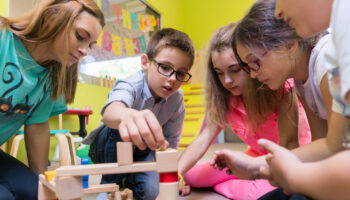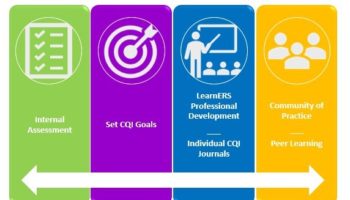Quality Tips
by Pam Schaffner
The assessment team in PA is often asked if they have any tips to make meeting quality standards easier. Since they have experiences visiting many programs in their professional careers, they have seen many programs employ strategies to make things easier, more efficient, and more effective. Implementing quality can be stressful or time consuming, but always worth it. So, this Q-T Corner moment aims at helping you along the way.
Installment #7
Data Trends
Did you know that the Program Quality Assessment team can review data trends from the assessments they conduct? The assessors collect data using a hand-held computer. If you have had an assessment before, you have seen these in use. In fact, assessments using a database rather than paper have been conducted in Pennsylvania since January 2004. All of that data is stored for each assessment and each program. The data is uploaded to a server that keeps it, sorts it, and analyzes it.
We can learn a lot about where PA childcare programs thrive in implementing quality childcare practices. We can also see where more improvements can happen in providing quality practices for young children. The Environment Rating Scales score various items the same across each type (ITERS, ECERS-R, ECERS-3, SACERS-U, FCCERS-R). There are many reasons why scores can be lower on particular items than they are on others. Some items are more challenging to implement than others; some items are costly to implement (such as the cost of playground improvements); and some item scores may not improve because of structural challenges that may not be fixable (such as no windows in a basement classroom).
We can look at the data trends to determine WHAT the lower scoring items (and indicators) are for each scale. We may not be able to ascertain WHY the score is lower as this may vary from program to program. The data is factual and is the initial starting point for continuous quality improvement (CQI) efforts. Rather than looking back all the way to 2004, the trends highlighted below look back 5 years.
That data presented here considers classroom practices. Therefore, high/low scores relating to staff or parent policies were not included. The ERS scores range from 1-7 with a 7 representing the highest level of quality or enhanced developmentally appropriate practices. The scores below represent the average score for the item across the 5-year data search range.
ITERS-R Data from July 2015 to July 2020
The top 2 scoring Items were:
#27 Staff-child interaction (6.43) and #32 Provisions for children with disabilities (6.25)
The lowest 2 scoring Items were:
# 7 Meals and snacks (1.9) and #11 Safety practices (1.83)
It was difficult for programs to maintain sanitary procedures which include table sanitizing, washing hands before and after eating, and serving uncontaminated foods. Another low scoring indicator was staying within arm’s reach of anyone eating for safety purposes.
For #11 Safety practices, indoor safety concerns were observed frequently. Safety hazards include locking items labeled “Keep Out of Reach of Children,” covering outlets, making sure children do not have access to choking hazards including small art supplies and ensuring that the diaper changing table has a 6-inch lip/raised edge to ensure children do not fall. A more comprehensive list of safety hazards to look for is included in the ITERS-R itself.
ECERS-R data from July 2015 to July 2020
The top 2 scoring items were:
#16 Encouraging children to communicate (6.62) and # 32 Staff-child interactions (6.68)
The lowest 2 scoring items were:
#7 Space for gross motor play (2.22) and #14 Safety practices (1.59)
Programs found it difficult to ensure a safe space for gross motor. Common things observed are fences that are too low or are not present, mulch that is worn away to less than 9 inches deep, crowded playground equipment so each piece does not have a use zone around it, or a lack of structural bollards for playgrounds located close to streets and parking lots. For a list of safety concerns on playgrounds, please see the Playground Information on the Ersi website. https://www.ersi.info/PDF/playground%20revised%207-31-18.pdf
For Item #14 Safety practices, the outdoor playground concerns affect the score of this item as well. There are also indoor safety concerns commonly observed. These include locking items labeled “Keep Out of Reach of Children” and covering electrical outlets. A more comprehensive list of safety hazards to look for is included in the ECERS-R itself.
ECERS-3 data from July 2015 to July 2020
The top 2 scoring items were:
#1 Indoor space (5.06) and #30 Staff-child interactions (6.01)
The lowest 2 scoring items were:
#20 Blocks (2.31) and #25 Understanding written number (1.99)
Few interactions were observed with children using blocks. Blocks are building toys that stack and slide. Their sides do not stick together or connect like Lincoln logs, Legos, or magnetic blocks. Instead, a child learns to balance blocks as he or she builds. There is an expectation that teachers talk to the children while they build. The data shows that this practice is not consistently happening across programs.
For Item #25 Understanding written number, the data suggests that there are largely three reasons for this item scoring lower than others in the ECERS-3. First, there is an expectation that the classroom display includes math posters or pictures that show the concept of quantity. This means that the posters do not just show the numerals 0-10. But, instead, show what those numerical symbols mean. A poster that shows the number 2 next to a picture of 2 cows would meet the expectation. The second and third reasons involve staff action in relation to the written number materials in the classroom. Staff should look for opportunities to point out numbers in play materials and help children relate printed numbers to an image of their quantity.
SACERS-U data from July 2015 to July 2020
The top 2 scoring items were:
#16 Departure (6.84) and #28 Staff-child interactions (6.78)
The lowest 2 scoring items were:
#2 Space for gross motor activities (2.29) and #14 Safety practice (1.62)
Programs found it difficult to ensure the gross moto space was hazard free. Oftentimes school–age programs use playgrounds that are not fenced, are close to parking lots, have unsafe and/or old equipment, etc. For a list of safety concerns on playgrounds please see the Playground Information on the ERSi website. https://www.ersi.info/PDF/playground%20revised%207-31-18.pdf
For Item # 14 Safety practices, the outdoor hazards affect the score of this item. There are also indoor hazards to consider. These include locking items labeled “Keep Out of Reach of Children” and covering electrical outlets in programs that serve children under the age of 6. A more comprehensive list of safety hazards to look for is included in the SACERS-U itself.
FCCERS-R data from July 2015 to July 2020
The top 2 scoring items were:
#7 Greeting/departing (6.59) and # 28 Provider-child interactions (6.52)
The lowest 2 scoring items were:
#8 Nap/rest (2.18) and #12 Safety practices (1.49)
Item #8 Nap/rest presented data that programs were not able to attain healthy nap practices. In many cases the cribs, cots and mats are not separated enough to prevent the spread of germs. To meet minimal health standards using the FCCERS-R, separating these provisions by 24 inches on 3 open sides is expected. For better health practices, separating these provisions by 36 inches is expected. Also, during the COVID-19 pandemic, to maintain healthy practices, the standard has been increased to 6 feet, if possible. 3 open sides mean that nothing is in the way between that side of the mat/cot/crib and any other child or piece of furniture. Placing children at an appropriate separation but placing toys chairs, etc. in between them means that the side is no longer considered an “open” side. For more information on spacing during COVID-10 see https://www.cdc.gov/coronavirus/2019-ncov/community/schools-childcare/guidance-for-childcare.html
For Item # 12 Safety practices, the majority of safety hazards found are indoors. Safety hazards include locking items labeled “Keep Out of Reach of Children,” covering outlets, making sure children do not have access to choking hazards including small art supplies, and ensuring that the diaper changing table has a 6-inch lip/raised edge to ensure children do not fall. The last 2 apply to infants and toddlers if the program enrolls these age groups. A more comprehensive list of safety hazards to look for is included in the FCCERS-R itself. Just as a reminder for this program, items labeled “Keep Out of Reach of Children” or any other unsafe item such as kitchen knives are expected to be locked if children in care ever use the room in which they are located. So, for example, if the children eat in the kitchen, knives in that room are to be locked. If children use a particular bathroom, items in a medicine cabinet or behind a shower curtain that belong to family members are also expected to be locked if they are labeled “Keep Out of Reach of Children.”
*******Overall reflection on the data********
The data reflects some commonalities across all scales. Programs seem to all be doing quite well with teacher-child interactions. This means that Pennsylvania teachers are overall showing warmth towards children. They are sympathetic when children are upset or need extra help. They overall demonstrate that they enjoy being with children and work towards developing relationships with each child. A child’s need for a sense of belonging in the community of a classroom is foundational to learning. This is a huge strength. The data also suggests that programs could increase overall quality by doing a few things. First, install electrical outlets that automatically close. These are inexpensive and staff will no longer need to check outlets for covers. Secondly, programs could also do a scavenger hunt through the rooms looking for items labeled “Keep Out of Reach of Children.” Lock these items up. Third, consider the playground hazards. As mentioned above, some quality items are more difficult to implement. Playground enhancements are expensive. Perhaps, if you see that you have many hazards and want a playground upgrade, you can put this on your wish list or your long-term goals list. Seek out funding and keep an eye on improvement.




